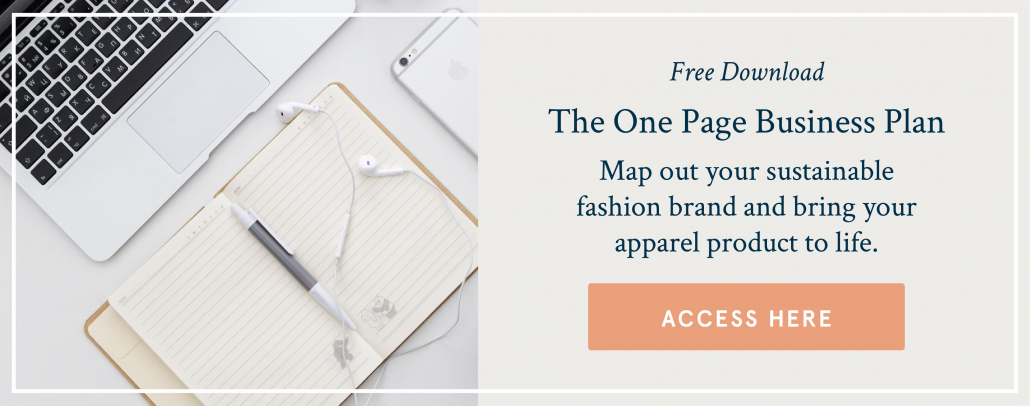Podcast Ep. 19: This is the Business Model for the Future of the Fashion Industry
Listen on Apple Podcasts | Listen on Spotify
When you think about choosing a business model — your thoughts may immediately go to the question of how you’re going to sell. Will you sell direct to consumer? Will you sell wholesale to stores and boutiques? And while those are all important decisions to think about and make, the business model I want to talk about today is one that is *actually* sustainable – not only in terms of the planet and the environment – but when it comes to your wallet and business revenue. This is a business model that could significantly shape the way that you build your sustainable fashion brand and help to change the fashion industry as a brand yourself.
Resources mentioned in this episode:
TRANSCRIPT
When you think about choosing a business model — your thoughts may immediately go to the question of how you’re going to sell. Will you sell direct to consumer? Will you sell wholesale to stores and boutiques? Will you sell through online marketplaces? Will you sell omni channel, meaning a combination of all of those things?
And while those are all important decisions to think about and make, the business model I want to talk about today is one that is *actually* sustainable – not only in terms of the planet and the environment – but when it comes to your wallet and business revenue.
This is a business model that could significantly shape the way that you build your sustainable fashion brand and help to change the fashion industry as a brand yourself.
But first, let me backup for a second: if you’re new to the fashion industry, and you’re hearing me say the fashion industry needs to be changed, then you may be wondering, why? What’s so bad about the way fashion operates today?
And here’s the deal: Most brands (from the fast fashion and household name brands to the smaller, independent brands) create an entire season’s worth of clothing all at once, making guesses based on projections and calculations about which garments will be popular and sell.
They then sell as much as they can at full price, before putting the remaining inventory on sale or selling it to discount outlets. But here’s the worst part: the remaining, unsold merchandise is thrown out to be incinerated or discarded into a landfill. Because the majority of clothing that’s made today is synthetic, made from petroleum-based fabrics like polyester or nylon, it can take 200 years for that unsold merchandise to decompose in a landfill. This is part of the reason why people talk about the fashion industry being one of the major industrial polluters.
And to be honest, most consumers as well as most brands, didn’t have much of a problem with how the fashion industry was operating until the pandemic hit. And that’s when the business of fashion was absolutely ravaged — in loss of revenue, in unsold inventory and in waste.
There’s a great read by Elizabeth Segran of Fast Company who describes what happened in March 2020, right as the world went into lockdown, when consumers lost interest in buying fashionable clothing — and that cost the big brands millions of dollars in unsold inventory. Some of them even filing for bankruptcy.
In a normal year, an estimated 30% of goods go unsold; in 2020, those losses were closer to 50-60%. According to The Wall Street Journal, last year, brands like Ralph Lauren had $160 million worth of inventory that was sold off for less than the company paid for it; Urban Outfitters has $43 million, and Columbia Sportwear has $9.3 million.
On the other hand, here’s what I was seeing with the small independent brands and the sustainable fashion brands that have graduated from Factory45: for many of them, March 2020 was their best month of revenue ever. The pandemic hit and it was their best. Month. ever. The brands that were already doing well started to do even better because there was a shift in consumer attention to support small businesses and help them get through the pandemic.
And while things are slowly starting to get back to normal, the past year and a half not only shed light on how fragile the traditional fashion industry is but a potentially better way for the fashion business model to operate as a whole.
Ironically, it’s a business model that many sustainable fashion and small independent brands were already operating. And it’s called on-demand manufacturing.
On-demand manufacturing.
I’ve seen my own Factory45 entrepreneurs use this model, I’ve seen brands in the industry like Misha Nonoo shift to this model and it’s becoming an increasingly available option as more factories and manufacturers open up to the idea of adjusting their operations to fit this model.
What on-demand manufacturing means is that your factory only starts sewing the garment or product after your customer places an order. This model is slightly different from pre-selling which is my favorite type of launch method but they are essentially the same thing. I think of pre-selling as a way of launching your brand for the first time to get a bulk set of orders to fund your first production run and then on-demand manufacturing would be a way of continuing with orders and production as you continue selling. But, both methods are a pre-sale.
There are so many reasons to consider on-demand manufacturing for your own brand and I’m going to go through some of those reasons in more detail now. Even if you already think you have your manufacturing set up, listen with an open mind. Because you may find on-demand manufacturing to be really appealing and you’ll want some reasons to help negotiate with your factory to work with you in this way.
Alright, so reason #1 to consider on-demand manufacturing once you’ve launched your brand and want to continue selling is that it doesn’t require you to hold inventory.
This is a huge benefit. One of the most common questions that I get from my Factory45 entrepreneurs when they’re about to start production is, “But Shannon, how do I plan for inventory after my first production run?” How much extra do I produce? How many of each size do I need to order?
And with on-demand manufacturing, you don’t have to make those decisions — it’s a huge weight off to only produce what is actually ordered and paid for by your customer.
What this also means is that less capital is needed all at once. That’s reason #2. The typical fashion model requires you to have at least $10K-20K to continue placing orders with your factory on a bi-monthly or quarterly basis. With on-demand manufacturing, you don’t need a bulk influx of cash to continue production because your customer is paying for it in advance.
And then of course, reason #3, when it comes to being more sustainable for the planet, on-demand manufacturing reduces waste. You’re not creating designs that don’t sell, you’re not holding a warehouse of inventory that’s just sitting unsold. And you’re able to test the designs that your customers actually want before making anything.
Sounds pretty good, right? So just as a quick review, three of the main benefits of on-demand manufacturing are: no inventory, less capital needed upfront and less fashion waste produced. Especially when you’re a startup brand — you may have an initial pre-sale of bulk orders (which is what I recommend and I’ll talk about on another live show) but then this on-demand manufacturing model is a great option for continuing to sell after your initial launch.
As with most things in life, this model isn’t perfect. There are a few things to be aware of if you do try to pursue this as a business model and the first one is that there aren’t a ton of factories that have bought into the idea. We’ve seen a few here in the U.S. who are open to operating in this way, one of them closed down unfortunately during the pandemic, but the model is starting to be adopted in other facilities. This is also where building a relationship with your factory is so, so important and if you know me then you know that this is something I harp on relentlessly. This industry is all about building relationships and when you build reciprocated relationships it opens the doors for negotiation.
The other thing to be aware of is that you still have to purchase fabric, trims and notions upfront. For your factory to be able to produce the garment, they have to have all of the materials in-house at the factory so that does require an upfront purchase of those materials. This is still a significantly less upfront investment than paying for materials and paying for the labor all at once.
And then the third thing is that because you’ll be producing each garment one by one the cost per unit will likely be higher. This means you’ll have lower margins, depending on your retail price point. In my opinion, as long as the business is healthy, I would take the lower margin in the beginning for the benefit of producing on-demand.
This is all to say that if you’re starting your brand now, there is massive opportunity to do better. The fashion industry as we know it is crumbling and there is opportunity to be part of the rebuild. With more consumers prioritizing small businesses and independent brands, I truly believe it’s never been a better time to start a sustainable fashion brand.
We have Factory45 alumni like Vesta Studio operating on an on-demand model, we have other alumni like Sotela and Harly Jae doing quarterly pre-sales, and there are plenty of other examples of brands taking this slower approach and seeing success with it. I’ll link to the Fast Company article I mentioned and you can read more about the brands they highlight as example of this on-demand manufacturing model. If nothing else, it’s something to consider and be inspired by as you develop your brand and business.
If you’re interested in learning more about how to make this business model work for your brand, book a call with Hannah, our Director of Enrollment. She can help you talk through your business goals and see if Factory45 is the right fit for launching your fashion or accessories brand. To book a free consult call with her, just go to factory45.co/apply
Thank you to everyone, so much for being in this community – it truly means so much when you continue to listen to new episodes and are open to learning something new. It sets you apart from the 99% of other people who aren’t prioritizing their continued education in this space. So kudos to you.



